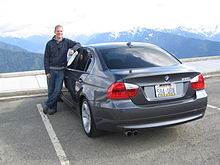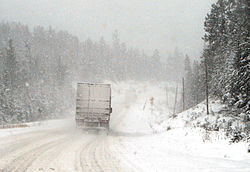- Driving
-
For other uses, see Driving (disambiguation).
Driving is the controlled operation and movement of a land vehicle, such as a car, truck or bus.
Although direct operation of a bicycle and a mounted animal are commonly referred to as riding, such operators are legally considered drivers and are required to obey the rules of the road. Driving over a long distance is referred to as a road trip.
Contents
History
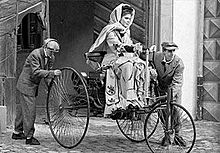 Bertha Benz, the first long distance automobile driver in the world, driving the Benz Patent-Motorwagen ca. 1886.
Bertha Benz, the first long distance automobile driver in the world, driving the Benz Patent-Motorwagen ca. 1886.
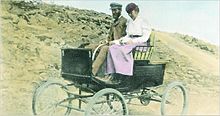 In 1899 an automobile was driven to the summit of Mount Washington for the first time.
In 1899 an automobile was driven to the summit of Mount Washington for the first time.
The world's first long distance road trip by automobile[1] took place in Germany in August 1888 when Bertha Benz, the wife of Karl Benz, the inventor of the first patented motor car (the Benz Patent-Motorwagen), travelled from Mannheim to Pforzheim[2] (a distance of 106 km (66 mi))[3] in the third experimental Benz motor car (which had a maximum speed of 10 mph) and back, with her two teenage sons Richard and Eugen but without the consent and knowledge of her husband. Her official reason was that she wanted to visit her mother but unofficially she intended to generate publicity for her husband's invention (which had only been used on short test drives before), which succeeded as the automobile took off greatly afterwards and the Benz's family business eventually evolved into the present day Mercedes-Benz company.[4]
In 1899, F. O. Stanley and his wife Flora drove their Stanley Steamer automobile, sometimes called a locomobile, to the summit of Mount Washington in New Hampshire in the United States and to generate publicity for their automobile.[5] The 7.6 mile journey took over two hours (not counting time to add more water); the descent was accomplished by putting the engine in low gear and doing lots of braking.[5]
Driveability
Driveability of a vehicle means the smooth delivery of power, as demanded by the driver. Typical causes of driveability degradation are rough idling, misfiring, surging, hesitation, or insufficient power.[6]
Driving skills
Driving in traffic is more than just knowing how to operate the mechanisms which control the vehicle; it requires knowing how to apply the rules of the road (which govern safe and efficient sharing with other users). An effective driver also has an intuitive understanding of the basics of vehicle handling and can drive responsibly.
Driving as a physical skill
In terms of the basic physical tasks required, a driver must be able to control direction, acceleration, and deceleration. For motor vehicles, the detailed tasks include: [7]
- Starting the vehicle's engine with the starting system
- Setting the transmission to the correct gear
- Depressing the pedals with one's feet to accelerate, slow, and stop the vehicle, and if the vehicle is equipped with a manual transmission, to modulate the clutch
- Steering the vehicle's direction with the steering wheel
- Operating other important ancillary devices such as the indicators, headlights, and windshield wipers
Driving as a mental skill
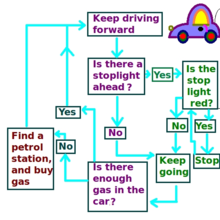 Driving as a mental skill is like a constantly re-adjusting flowchart.
Driving as a mental skill is like a constantly re-adjusting flowchart.
Avoiding or successfully handling an emergency driving situation can involve the following skills: [8]
- Making good decisions based on factors such as road and traffic conditions
- Evasive maneuvering
- Proper hand placement and seating position
- Skid control
- Steering and braking techniques
- Understanding vehicle dynamics
Distractions can compromise a driver's mental skills. One study on the subject of mobile phones and driving safety concluded that, after controlling for driving difficulty and time on task, drivers talking on a phone exhibited greater impairment than drivers who were suffering from alcohol intoxication.[9]
Another survey indicated that music could affect adversely a driver's concentration.[10]
Seizure disorders and Alzheimer's disease are among the leading medical causes of mental impairment among drivers in the United States and Europe.[11] Whether or not physicians should be allowed, or even required, to report such conditions to state authorities, remains highly controversial.[11]
Driving laws
A person is subject to the laws of the jurisdiction in which he or she is driving. The rules of the road, driver licensing and vehicle registration schemes that apply vary considerably between jurisdictions, as do laws imposing criminal responsibility for negligent driving, vehicle safety inspections and compulsory insurance. Most countries also have differing laws against driving whilst under the influence of alcohol or drugs.
Most countries require a vision screening test for individuals to acquire or renew a driver's license.[citation needed] A 2010 systematic review[12] found insufficient evidence to assess the effects of vision screening tests on subsequent motor vehicle crash reduction. The review concluded that there is a need to develop valid and reliable tools of vision screening that can predict driving performance.
Motorists are almost universally required to take lessons with an approved instructor and pass a driving test before being granted a license. Almost all countries allow all adults with good vision to apply to take a driving test and, if successful, to drive on public roads. Saudi Arabia, however, bans women from driving vehicles (whether pedal or motor powered) on public roads. Saudi women have periodically staged driving protests against these restrictions.
In many countries, even after passing one's driving test, new motorists may be initially subject to special restrictions. For example, in Australia, novice drivers are required to carry "P" ("provisional") plates, and are subject to alcohol limits, and other restrictions for their first two years of driving. Another example, in California, licensed drivers (ages 16) are able to drive only with a family member for the first year. Yet in most states(mostly on the eastern coast) any licensed driver can take friends with them as long as both parents/guardians approve. These states include: Georgia, Alabama, South and North Carolina and Virginia.
Driving and occupational therapy
When effects of aging or a health condition impact the ability to drive, an occupational therapist can provide assessment to determine fitness to drive. An occupational therapist may suggest adaptive equipment, or a driver refresher program to keep older adults driving for as long and as safely as possible. When driving is no longer an option, occupational therapists prepare older adults for driving retirement and offer solutions to community mobility.
See also
- Aggressive driving
- Automobile
- Back seat driver
- California stop
- Chauffeur
- Clutch control
- Cruising
- Defensive driving
- Drifting (motorsport)
- Driver's education
- Driver's license
- Driverless car
- Driving pleasure
- Driving under the influence
- Fuel economy-maximizing behaviors (a.k.a. eco-driving, green driving)
- Graduated driver licensing
- Heel-and-Toe
- Highway Code (official road safety manual for the United Kingdom)
- Highway patrol
- Institute of Advanced Motorists
- Mobile phones and driving safety
- Occupational therapy
- Railroad engineer
- Road safety
- Road racing
- Road rage
- Road trip
- Sleep Deprived Driving
- Traffic directionality
- Traffic jam
- Traffic sign
- Vehicle dynamics
References
- ^ The First Road Trip
- ^ Making of 'Carl & Bertha' (German TV-Film)
- ^ GPS-Download Outbound Trip
- ^ The Car is Born documentary
- ^ a b CHRISTOPHER JENSEN (June 17, 2011). "Taming a Mountain Road With Horses and Cars". The New York Times. http://www.nytimes.com/2011/06/19/automobiles/19MOUNTAIN.html. Retrieved 2011-09-29. "That was the day that F. O. Stanley and his wife, Flora, decided it would be good publicity for their steam-powered Stanley Locomobile if it were the first car to be driven up the 7.6-mile Mount Washington Carriage Road."
- ^ http://www.arb.ca.gov/msprog/zevprog/hevtest/071608aftermarketpartsdraftrev.pdf
- ^ "Getting moving". Driving Test Advice. http://www.drivingtestadvice.co.uk/Lesson_Help/1__Getting_moving/1__getting_moving.html.
- ^ "Think driving is all about practical skills?". Easy to Drive. http://www.easytodrive.co.uk/.
- ^ Strayer, David; Drews, Frank; Crouch, Dennis (2003). "FATAL DISTRACTION? A COMPARISON OF THE CELL-PHONE DRIVER AND THE DRUNK DRIVER" (PDF). University of Utah Department of Psychology. http://www.psych.utah.edu/AppliedCognitionLab/DrivingAssessment2003.pdf
- ^ Hard-Rock and Classic Music Could Lead to Road Accidents, New Survey Says
- ^ a b Jacob M. Appel "Must Physicians Report Impaired Driving? Rethinking a Duty on a Collision Course with Itself" Journal of Clinical Ethics Volume 20 Number 2.
- ^ Desapriya, E.; Wijeratne, H.; Subzwari, S.; Babul-Wellar, S.; Turcotte, K.; Rajabali, F.; Kinney, J.; Pike, I. (2011). "Vision screening of older drivers for preventing road traffic injuries and fatalities". In Desapriya, Ediriweera. Cochrane Database of Systematic Reviews. doi:10.1002/14651858.CD006252.pub3.
Further reading
- Pease, Bob; How to Drive Into Accidents ... and How Not To (1998); Pease Pub; ISBN 978-0965564816 — An idiosyncratic, entertaining, and insightful book on safe driving techniques, written for novices and experienced drivers alike
External links
- How Cars Work - also How to Drive.
- "Drivers with dementia a growing problem, MDs warn". CBC News. 2007-09-19. http://www.cbc.ca/health/story/2007/09/19/drivers-dementia.html?ref=rss. Retrieved 2008-01-20.
- "Driving research wiki". Simulator Users Group. http://www.drivingwiki.org. Retrieved 2008-01-20.
- Enjoy Motoring
Categories:
Wikimedia Foundation. 2010.

